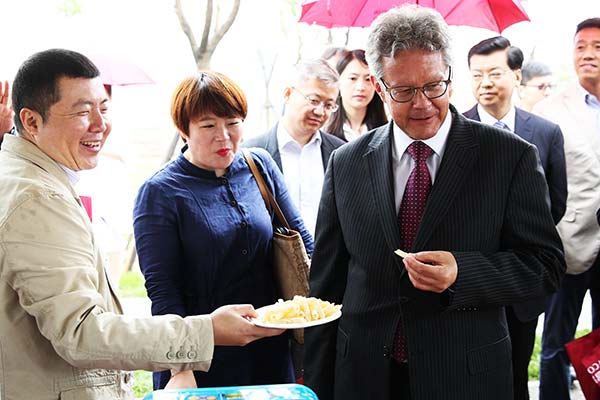 |
|
Ronald Keller, Dutch ambassador to China, tastes food at an exhibition in Beijing organized by China National Cereals, Oils and Food-stuffs Corp, a major State enterprise in China.[Provided to China Daily] |
More mergers and acquisitions in the pipeline, and bigger production capacity cutbacks envisaged
China will further push ahead with its restructuring of State-owned enterprises this year, cutting overcapacity and keeping the total number of key SOEs under 100, the country's top State assets watchdog said in a statement on Thursday.
A total of 10 State enterprises are currently in the middle of mergers and acquisitions, and several others are in the pipeline for similar restructuring in the second half of this year.
The target is to cut the total number of central SOEs from 105 to 100 within the year, the State-owned Assets Supervision and Administration Commission said.
Officials at the watchdog said that six State companies, including China National Building Materials Group Corp, China National Materials Group Corporation Ltd, State Nuclear Power Technology Corporation and China Power Investment Corporation, are under a pilot plan for merger and acquisitions.
The number of SOEs affiliated to the central government, or the country's central SOEs, has dropped from 112 in 2015 to 105 this year, amid a government-driven reform to streamline the resources of State-owned assets.
Despite the sluggish world economy, SOEs have been improving their relative financial performances gradually in the first half of the current year, with a slowdown in the decline of profits.
That's due to a series of measures adopted to improve SOE management and to cut redundant manufacturing capacity, especially in sectors such as steel, coal and glass manufacturing.
The regulator said it plans to cut another 15 percent of the manufacturing capacity of steel and coal products of SOEs over the next five years.
As China moves to boost innovation and implement supply-side reforms, the country is trying to slash overcapacity in the labor-intensive coal and steel sectors.
The regulator reported that SOEs made 623.5 billion yuan ($93.3 billion) in profits during the first six months of the year, down 3 percent year-on-year, according to the SASAC.
The regulator reported that more State-owned enterprises were experiencing a rebound in profits in the first six months of 2016, as 38 of them achieved a profit growth of more than 10 percent and 16 recorded a growth rate of more than 30 percent.
Huang Qunhui, director of the institute of industrial economics at the Chinese Academy of Social Sciences, said State enterprises played a key role in keeping the economy stable and sound. "But SOEs will still have to go through a deepening reform progress, because of the tougher global competition and the transformation of the Chinese economy," Huang added.
They could also help drive the pace of industrialization and enhance the country's competitive edge from a global perspective, Huang said.
